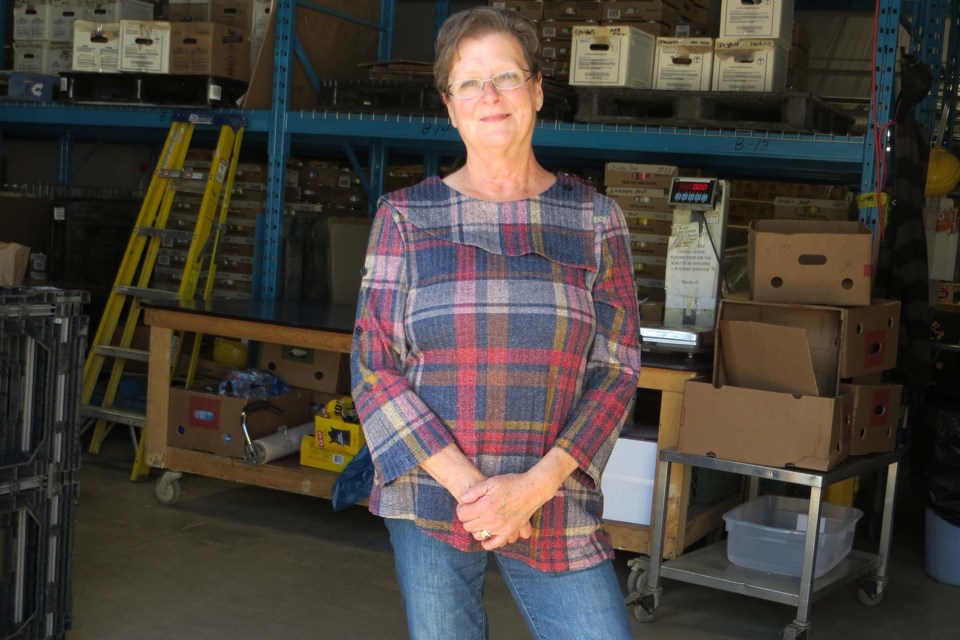The massive metal-warehouse doors at St. Albert Food Bank slowly rise. A transport truck cautiously backs up and lowers a skid containing donated food from Costco.
At a quick glance, the cardboard box is jammed with pita bites, bread, bags of potatoes, and boxes filled with cherries, lemons, tomatoes, and peaches.
“Costco and Walmart have a corporate mandate to not throw out food. They send food every day and we have volunteers who go through it and pick out the fuzzy berries,” chuckled executive director Suzan Krescy referring to the occasional basket of damaged fruit.
It’s not just Costco and Walmart. Every local grocer does their part to supply the food bank with groceries and personal care items that for various reasons cannot be sold. Canned fruits and vegetables, sauces, breakfast cereals, pasta, flour, sugar, meats, canned fish, frozen foods, baby formula, diapers, and pet food are only a small part of the donations.
“We can prepare sugar free, gluten free, lactose free, and halal hampers.”
The 11,000 square foot facility can contain about 63,000 pounds of items (nearly 28,500 kilograms). At the moment, there are many empty spaces and shelves.
Despite grocery support and public donations, the food bank distributed 58,000 pounds of goods (26,300 kilograms) in June. It fed 1,200 people, a historic high since the food bank first opened in 1984.
“We’re just keeping our heads above water. There’s a high demand and I’m grateful produce gardens are starting to come in, which is wonderful.” Krescy said.
Currently, there are 1,100 families on file, with about 90 per cent residing in St. Albert. There is a small number from Sturgeon County that also includes Jessie’s House, a trauma facility that assists women, children, and the elderly fleeing domestic violence.
Krescy explained that typically, donations drop in May and June across Canada when children finish school.
“It’s the end of school year and people want to get away, so it’s not top of mind.”
Back in March 2020 during Canada’s initial industry shutdown, demand surged until CERB cheques were issued. The demand plateaued until Oct. 2021, when government support was cancelled. As inflation rose and the cost of living accelerated dramatically, families and individuals living paycheque to paycheque faced a crisis.
The Bank of Canada’s July 12 announcement raising mortgage rates one per cent to cool inflation has placed additional burdens on families in difficult situations, noted Krescy.
“Families that used to be donors are now finding themselves in a financial pickle. They are giving less because they need to feed their own families. The stress on them is significant, and the added stress wreaks havoc on mental health, from domestic violence to suicidal thoughts. For more people there doesn’t seem to be a light at the end of the tunnel.”
The food bank presently receives requests from diverse individuals with varying needs: young families, seniors on a fixed income, servers who depend on tips, and administrative assistants. While the stereotypical belief is that the trades earn “good money,” some companies do not pay employees if work is unavailable due to poor weather conditions, said Krescy.
Substance abuse, the high cost of childcare, and lack of transportation also factor into whether individuals can find or keep a job.
“Does the job pay enough to live? When the power bills and rent go up, what do you do? Certainly, people are employed, but are they paid enough to meet their financial obligations?”
When The Gazette asked Krescy what items were needed to restock shelves she replied, “Everything. We need everything.” She then pointed out an empty shelf designated for infant formula.
"We really need infant formula. It goes quickly."
The food bank accepts food or monetary donations. Any monetary donation more than $10 receives a tax-deductible receipt. While purchasing food is a personal way of donating, Krescy added that since she receives a five-to 10-per-cent discount at box stores, she can restock shelves with more food from monetary donations.
The storage warehouse is located at 30-50 Bellerose Dr. For more information call 780-459-0599.


